The VvWRKY26-MBW Complex Induced by Salicylic Acid Promotes the Accumulation of Proanthocyanidins in Grape
Abstract
1. Introduction
2. Results
2.1. Phylogenetic Analysis of Grape WRKY Family
2.2. The Incubation of SA Promotes the Accumulation of VvWRKY26 in Grapes
2.3. Overexpression of VvWRKY26 Promotes the Accumulation of Proanthocyanins in Grape Callus
2.4. VvWRKY26 Interacts with the MBW Complex to Form a Tetramer
2.5. The Overexpression of the W-MBW Complex Promotes the Biosynthesis of Proanthocyanidins in Grape Leaves and Berries
2.6. The RNA Interference of the W-MBW Complex Inhibits Proanthocyanidin Content in Grape Leaves and Berries
2.7. VvWRKY26 Regulates VvANR and VvLAR2 Through the MBW Complex
3. Discussion
3.1. Phylogenetic Analysis of the WRKY Family in Grapevine
3.2. VvWRKY26 Positively Regulates SA-Mediated Proanthocyanidin Biosynthesis in Grapevines
3.3. The VvWRKY26-MBW Complex Regulates the Biosynthesis of Proanthocyanidins in Grapevine
4. Materials and Methods
4.1. Plant Materials
4.2. Bioinformatics Analysis
4.3. RNA Extraction and Real-Time Fluorescent Quantitative PCR
4.4. Salicylic Acid Incubation of Grapes
4.5. Subcellular Localization
4.6. Bimolecular Fluorescence Complementation
4.7. Transformation of Grape Leaves and Fruits
4.8. Transformation of Grape Callus Tissue
4.9. DMACA Staining and Determination of Total PAs
4.10. Determination of Flavan-3-ol Contents
4.11. Yeast One-Hybrid Assay
4.12. Yeast Two-Hybrid Assay
4.13. Dual-Luciferase Assay for Promoter Activity
4.14. Statistical Analyses
Author Contributions
Funding
Data Availability Statement
Conflicts of Interest
Appendix A
| Primer Name | Primer Sequence (5′→3′) | Enzyme Sites | Product Length (bp) | |
|---|---|---|---|---|
| Gene cloning | CDS-VvWRKY26 | F:ATGGAGATTAAAGAGTCTGAGAGGATAG | 1434 | |
| R:TCATGGTTTCTCTTTATTCGTATGGGC | ||||
| CDS-VvMYC2 | F:ATGAAAACTGAAATGGGTATGGGAGGA | 1827 | ||
| R:TTACCCAACTGATGATGACAAGGGC | ||||
| CDS-VvWDR1 | F:ATGGAGAGATCAAGCCAAGAATCCCA | 1011 | ||
| R:CTAAACTTTAAGAAGCTGCAGTTTGTTGG | ||||
| qRT-PCR | VvUBQ (BN000705) | F:GCTCGCTGTTTTGCAGTTCTAC | 151 | |
| R:AACATAGGTGAGGCCGCACTT | ||||
| VvLAR1 (AJ865336) | F:ACGATGTCCGAACACTGAAC | 189 | ||
| R:TGAACGCCGCTACTACACTC | ||||
| VvLAR2 (MW753045.1) | F:TCTCGACATACATGATGATGTG | 166 | ||
| R:TGCAGTTTCTTTGATTGAGTTC | ||||
| VvANR (AB199315) | F:AGAACTACAGGAGTTGGGTGAC | 168 | ||
| R:CCTTGAATTGCTGGCTTG | ||||
| VvANS (EF192468.1) | F:TATGAGGGCAAGTGGGTGAC | 238 | ||
| R:GAGGTGGGAAGAGTGGTGGC | ||||
| VvWRKY26 | F:GAACAAGCGAGCCCTCTAAG | 230 | ||
| R:TTCTGCTATCTGCCCATCCA | ||||
| VvMYBPA1 (AM259485) | F:GTCTCTCATCGCAGGTAGGC | 205 | ||
| R:GCTGATCTTGACCCTCTTGC | ||||
| VvMYBPA2 (EU919682.1) | F:GTGCGATGCTCCAAGGTTAT | 105 | ||
| R:CAGTGCTGAACTTGAGGGC | ||||
| VvMYC2 (NM_001281045.2) | F:AGGAATCCGAAGTGACCCG | 243 | ||
| R:GCCACAAATGCTTCCCAGA | ||||
| VvWDR1 (XM_010664551.3) | F:GGAACAAGCAGGATGTGAGG | 224 | ||
| R:ATTGGGTCCAGCAAGCGTAG | ||||
| Subcellular localization | SL-VvWRKY26 | F:CGAGCTCATGGAGATTAAAGAGTCTGAG | Sac I | 1431 |
| R:CGGATCCTGGTTTCTCTTTATTCGTATG | BamH I | |||
| BiFC | BiFC-VvWRKY26 | F:CGGATCCATGGAGATTAAAGAGTCTGAG | BamH I | 1431 |
| R:GCGTCGACTGGTTTCTCTTTATTCGTAT | Sal I | |||
| Overexpression | OE-VvMYC2 | F:GCTCTAGAATGAAAACTGAAATGGGT | Xba I | 1827 |
| R:GGGGTACCTTACCCAACTGATGAT | Kpn I | |||
| OE-VvWDR1 | F:GCTCTAGAATGGAGAGATCAAGCCA | Xba I | 1011 | |
| R:GGGGTACCCTAAACTTTAAGAAGCTG | Kpn I | |||
| OE-VvMYC2 | F:GCTCTAGAATGAAAACTGAAATGGGT | Xba I | 1827 | |
| R:GGGGTACCTTACCCAACTGATGAT | Kpn I | |||
| OE-VvWDR1 | F:GCTCTAGAATGGAGAGATCAAGCCA | Xba I | 1011 | |
| R:GGGGTACCCTAAACTTTAAGAAGCTG | Kpn I | |||
| RNAi | +RNAi-VvWRKY26 | F:CATTACAATTACATTTACAATTAATTTGTATCTGATGGAACTGGTCAAGAT | 300 | |
| R:TGTAACATAAGAAATTCTTACACTTCTCACTTTTCCTTCTCTTACTCCTG | ||||
| -RNAi-VvWRKY26 | F:GGTCAATTTGCAGGTATTTTTCTCACTTTTCCTTCTCTTACTCCTG | 300 | ||
| R:GCAGGACTCTAGGGACTAGTTTTGTATCTGATGGAACTGGTCAAGAT | ||||
| +RNAi-VvMYBPA1 | F:GGTCAATTTGCAGGTATTTCCATCTCCCCAAACCGGTTAG | 300 | ||
| R:GCAGGACTCTAGGGACTAGTAGTTGCAGATACTCTTCATACAGTTTG | ||||
| -RNAi-VvMYBPA1 | F:GGTCAATTTGCAGGTATTTAGTTGCAGATACTCTTCATACAGTTTGTC | 300 | ||
| R:GCAGGACTCTAGGGACTAGTCCATCTCCCCAAACCGGTTAGA | ||||
| +RNAi-VvMYBPA2 | F:CATTACAATTACATTTACAATTACGATTTCGACGAAAACCCGTCTC | 300 | ||
| R:TGTAACATAAGAAATTCTTACACGCCAGTGTCTTGAGCTCCAAAG | ||||
| -RNAi-VvMYBPA2 | F:GGTCAATTTGCAGGTATTTGCCAGTGTCTTGAGCTCCAAAG | 300 | ||
| R:GCAGGACTCTAGGGACTAGTCGATTTCGACGAAAACCCGTCT | ||||
| +RNAi-VvMYC2 | F:CATTACAATTACATTTACAATTACAATCTGGGGACTGGGGAGC | 300 | ||
| R:TGTAACATAAGAAATTCTTACACAGCCGAAACTCCTCTCTAACCC | ||||
| -RNAi-VvMYC2 | F:GGTCAATTTGCAGGTATTTAGCCGAAACTCCTCTCTAACCC | 300 | ||
| R:GCAGGACTCTAGGGACTAGTCAATCTGGGGACTGGGGAGC | ||||
| +RNAi-VvWDR1 | F:CATTACAATTACATTTACAATTATGGAGAGATCAAGCCAAGAATCCCA | 220 | ||
| R:TGTAACATAAGAAATTCTTACACTCGAAGGAGAGGCTGGGGTG | ||||
| -RNAi-VvWDR1 | F:GGTCAATTTGCAGGTATTTTCGAAGGAGAGGCTGGGGTG | 220 | ||
| R:GCAGGACTCTAGGGACTAGTTGGAGAGATCAAGCCAAGAATCCCA | ||||
| Yeast-one hybridization | Q-Y1H-VvLAR1 | F:CCAAGCTTTCCGATTGTCTCGG | Hind III | 142 |
| R:GGGGTACCCATATAGGGCTGG | Kpn I | |||
| Q-Y1H-VvLAR2 | F:CCAAGCTTTGGGGAAGAAGATACCTAT | Hind III | 173 | |
| R:GGGGTACCTCTCGAAAAGATAAATTCA | Kpn I | |||
| Q-Y1H-VvANR | F:CCAAGCTTCCTATATCTCAGCCAC | Hind III | 242 | |
| R:GGGGTACCCTATGATTCAACAGATG | Kpn I | |||
| Q-Y1H-VvANS | F:CCAAGCTTGGGTTTATCAGAAATTGAC | Hind III | 170 | |
| R:GGGGTACCACACGTTTCAGC | Kpn I | |||
| AD-VvWRKY26 | F:CGGAATTCATGGAGATTAAAGAGTCTGA | EcoR I | 1434 | |
| R:CGGGATCCTCATGGTTTCTCTTTAT | BamH I | |||
| Dual luciferase assay | proVvANR | F:ACTCACTATAGGGCGAATTGGGTACC TAGATTTGGATGACTATTGG | 1605 | |
| R:GCGGCCGCTCTAGAACTAGTGGATCC ATGCCCTCACTTCCAAATTC | ||||
| ProVvLAR2 | F:ACTCACTATAGGGCGAATTG GATGATAAGATTCAAGTGTCAAGTGC | 1770 | ||
| R:GCGGCCGCTCTAGAACTAGT ATCGGTGTTAATTTTCTGAGAAAGAAG |
References
- Poudel, P.R.; Koyama, K.; Goto-Yamamoto, N. Evaluating the influence of temperature on proanthocyanidin biosynthesis in developing grape berries (Vitis vinifera L.). Mol. Biol. Rep. 2020, 47, 3501–3510. [Google Scholar] [CrossRef]
- Sun, Q.; Zhang, T.; Xiao, Q.; Mei, B.; Zhang, X. Procyanidin B2 inhibits angiogenesis and cell growth in oral squamous cell carcinoma cells through the vascular endothelial growth factor (VEGF)/VEGF receptor 2 (VEGFR2) pathway. Bioengineered 2022, 13, 6500–6508. [Google Scholar] [CrossRef]
- Yu, D.; Huang, T.; Tian, B.; Zhan, J. Advances in Biosynthesis and Biological Functions of Proanthocyanidins in Horticultural Plants. Foods 2020, 9, 1774. [Google Scholar] [CrossRef]
- Wu, Y.; Wen, J.; Xia, Y.; Zhang, L.; Du, H. Evolution and functional diversification of R2R3-MYB transcription factors in plants. Hortic. Res. 2023, 9, 1132–1147. [Google Scholar] [CrossRef] [PubMed]
- Mao, Z.; Jiang, H.; Wang, S.; Wang, Y.; Yu, L.; Zou, Q.; Liu, W.; Jiang, S.; Wang, N.; Zhang, Z.; et al. The MdHY5-MdWRKY41-MdMYB transcription factor cascade regulates the anthocyanin and proanthocyanidin biosynthesis in red-fleshed apple. Plant Sci. 2021, 306, 110848. [Google Scholar] [CrossRef] [PubMed]
- Ding, T.; Zhang, R.; Zhang, H.; Zhou, Z.; Liu, C.; Wu, M.; Wang, H.; Dong, H.; Liu, J.; Yao, J.L.; et al. Identification of gene co-expression networks and key genes regulating flavonoid accumulation in apple (Malus × domestica) fruit skin. Plant Sci. Int. J. Exp. Plant Biol. 2021, 304, 110747. [Google Scholar] [CrossRef]
- Nesi, N.; Jond, C.; Debeaujon, I.; Caboche, M.; Lepiniec, L. The Arabidopsis TT2 gene encodes an R2R3 MYB domain protein that acts as a key determinant for proanthocyanidin accumulation in developing seed. Plant Cell 2001, 13, 2099–2114. [Google Scholar] [CrossRef]
- Feng, L.S.; Allen, P.J.; Napoli, R.S.; Browne, R.G.; Pham, H.; Parish, R.W. MYB-bHLH-TTG1 Regulates Arabidopsis Seed Coat Biosynthesis Pathways Directly and Indirectly via Multiple Tiers of Transcription Factors. Plant Cell Physiol. 2020, 61, 1005–1018. [Google Scholar]
- An, X.H.; Tian, Y.; Chen, K.Q.; Wang, X.F.; Hao, Y.J. The apple WD40 protein MdTTG1 interacts with bHLH but not MYB proteins to regulate anthocyanin accumulation. J. Plant Physiol. 2012, 169, 710–717. [Google Scholar] [CrossRef] [PubMed]
- Bogs, J.; Jaffé, F.W.; Takos, A.M.; Walker, A.R.; Robinson, S.P. The grapevine transcription factor VvMYBPA1 regulates proanthocyanidin synthesis during fruit development. Plant Physiol. 2007, 143, 1347–1361. [Google Scholar] [CrossRef]
- Liang, J.; Guo, J.; Liu, Y.; Zhang, Z.; Zhou, R.; Zhang, P.; Liang, C.; Wen, P. UV-C promotes the accumulation of flavane-3-ols in juvenile fruit of grape through positive regulating VvMYBPA1. Plants 2023, 12, 1691. [Google Scholar] [CrossRef] [PubMed]
- Liang, C.; Yang, B.; Wei, Y.; Zhang, P.; Wen, P. SA incubation induced accumulation of flavan-3-ols through activated VvANR expression in grape leaves. Sci. Hortic. 2021, 287, 110269. [Google Scholar] [CrossRef]
- Zhang, G.; Liang, C.; Guo, J.; Zhang, Z.; Zhang, P.; Zhao, Q.; Liang, J.; Wen, P. Cloning and expression analysis of VvWRKY26 gene in grapes. J. Agric. Biotechnol. 2023, 31, 475–487. (In Chinese) [Google Scholar]
- Imène Hichri Barrieu, F.; Bogs, J.; Kappel, C.; Delrot, S.; Lauvergeat, V. Recent advances in the transcriptional regulation of the flavonoid biosynthetic pathway. J. Exp. Bot. 2011, 62, 2465. [Google Scholar] [CrossRef]
- Verweij, W.; Spelt, C.E.; Bliek, M.; de Vries, M.; Wit, N.; Faraco, M.; Koes, R.; Quattrocchio, F.M. Functionally similar WRKY proteins regulate vacuolar acidification in petunia and hair development in Arabidopsis. Plant Cell 2016, 28, 786–803. [Google Scholar] [CrossRef]
- Li, C.; Wu, J.; Hu, K.D.; Wei, S.W.; Sun, H.Y.; Hu, L.Y.; Han, Z.; Yao, G.F.; Zhang, H. PyWRKY26 and PybHLH3 cotargeted the PyMYB114 promoter to regulate anthocyanin biosynthesis and transport in red-skinned pears. Hortic. Res. 2020, 7, 12. [Google Scholar] [CrossRef]
- Amato, A.; Cavallini, E.; Walker, A.R.; Pezzotti, M.; Bliek, M.; Quattrocchio, F.; Koes, R.; Ruperti, B.; Bertini, E.; Zenoni, S.; et al. The MYB 5-driven MBW complex recruits a WRKY factor to enhance the expression of targets involved in vacuolar hyper-acidification and trafficking in grapevine. Plant J. 2019, 99, 1220–1241. [Google Scholar] [CrossRef]
- Zhang, J.; Wang, Y.; Mao, Z.; Liu, W.; Ding, L.; Zhang, X.; Yang, Y.; Wu, S.; Chen, X.; Wang, Y. Transcription factor McWRKY71 induced by ozone stress regulates anthocyanin and proanthocyanidin biosynthesis in Malus crabapple. Ecotoxicol. Environ. Saf. 2022, 232, 113274. [Google Scholar] [CrossRef]
- Luo, Y.; Yu, S.; Li, J.; Li, Q.; Wang, K.; Huang, J.; Liu, Z. Molecular Characterization of WRKY Transcription Factors That Act as Negative Regulators of O-Methylated Catechin Biosynthesis in Tea Plants (Camellia sinensis L.). J. Agric. Food Chem. 2018, 66, 11234–11243. [Google Scholar] [CrossRef] [PubMed]
- Wang, Y.; Wang, X.; Fang, J.; Yin, W.; Yan, X.; Tu, M.; Liu, H.; Zhang, Z.; Li, Z.; Gao, M.; et al. VqWRKY56 interacts with VqbZIPC22 in grapevine to promote proanthocyanidin biosynthesis and increase resistance to powdery mildew. New Phytol. 2023, 237, 1856–1875. [Google Scholar] [CrossRef] [PubMed]
- Zhao, T.; Huang, C.; Li, N.; Ge, Y.; Wang, L.; Tang, Y.; Wang, Y.; Li, Y.; Zhang, C. Ubiquitin ligase VvPUB26 in grapevine promotes proanthocyanidin synthesis and resistance to powdery mildew. Plant Physiol. 2024, 1, kiae249. [Google Scholar] [CrossRef]
- Zhao, T.; Li, N.; Kong, J.; Li, X.; Huang, C.; Wang, Y.; Zhang, C.; Li, Y. An activator-represssor complex of VvWRKYs regulate proanthocyanidins biosynthesis through co-targeting VvLAR in grape. Int. J. Biol. Macromol. 2024, 281, 136653. [Google Scholar] [CrossRef] [PubMed]
- Lloyd, A.; Brockman, A.; Aguirre, L.; Campbell, A.; Bean, A.; Cantero, A.; Gonzalez, A. Advances in the MYB-bHLH-WD Repeat (MBW) Pigment Regulatory Model: Addition of a WRKY Factor and Co-option of an Anthocyanin MYB for Betalain Regulation. Plant Cell Physiol. 2017, 58, 1431–1441. [Google Scholar] [CrossRef]
- Guo, C.; Guo, R.; Xu, X.; Gao, M.; Li, X.; Song, J.; Zheng, Y.; Wang, X. Evolution and expression analysis of the grape (Vitis vinifera L.) WRKY gene family. J. Exp. Bot. 2014, 65, 1513–1528. [Google Scholar] [CrossRef]
- Gonzalez, A.; Brown, M.; Hatlestad, G.; Akhavan, N.; Smith, T.; Hembd, A.; Moore, J.; Montes, D.; Mosley, T.; Resendez, J.; et al. TTG2 controls the developmental regulation of seed coat tannins in Arabidopsis by regulating vacuolar transport steps in the proanthocyanidin pathway. Dev. Biol. 2016, 419, 54–63. [Google Scholar] [CrossRef]
- Alabd, A.; Ahmad, M.; Zhang, X.; Gao, Y.; Peng, L.; Zhang, L.; Ni, J.; Bai, S.; Teng, Y. Light-responsive transcription factor PpWRKY44 induces anthocyanin accumulation by regulating PpMYB10 expression in pear. Hortic. Res. 2022, 9, 2241–2252. [Google Scholar] [CrossRef]
- Wei, Y.; Yang, B.; Li, M.; Liang, Z.; Zhang, P.; Wen, P.; Niu, T. The effect of salicylic acid on the accumulation of phenolic substances in grape fruits. Shanxi Agric. Sci. 2021, 49, 554–559. (In Chinese) [Google Scholar]
- Woch, N.; Laha, S.; Gudipalli, P. Salicylic acid and jasmonic acid induced enhanced production of total phenolics, flavonoids, and antioxidant metabolism in callus cultures of Givotia moluccana (L.) Sreem. Vitr. Cell. Dev. Biol. 2023, 59, 227–248. [Google Scholar] [CrossRef]
- Yang, B.; Wei, Y.; Liang, Z.; Zhang, P.; Niu, T.; Fan, W.; Wen, P. The effect of exogenous salicylic acid on the accumulation of flavan-3-alcohol in grape leaves. Shanxi Agric. Sci. 2020, 48, 1916–1920. (In Chinese) [Google Scholar]
- Yang, B. Research on the Mechanism of Salicylic Acid Regulating VvMYBPA1/PA2 to Induce Flavan-3-alcohol Accumulation in Grape Leaves; Shanxi Agricultural University: Jinzhong, China, 2021. (In Chinese) [Google Scholar]
- Qu, C.; Fu, F.; Lu, K.; Zhang, K.; Wang, R.; Xu, X.; Wang, M.; Lu, J.; Wan, H.; Zhanglin, T.; et al. Differential accumulation of phenolic compounds and expression of related genes in black-and yellow-seeded Brassica napus. J. Exp. Bot. 2013, 64, 2885–2898. [Google Scholar] [CrossRef] [PubMed]
- Lim, S.H.; Kim, D.H.; Lee, J.Y. RsTTG1, a WD40 protein, interacts with the bHLH transcription factor RsTT8 to regulate anthocyanin and proanthocyanidin biosynthesis in Raphanus sativus. Int. J. Mol. Sci. 2022, 23, 11973. [Google Scholar] [CrossRef] [PubMed]
- Wen, P.F.; Ji, W.; Gao, M.Y.; Niu, T.; Xing, Y.; Niu, X. Accumulation of flavanols and expression of leucoanthocyanidin reductase induced by postharvest UV-C irradiation in grape berry. Genet. Mol. Res. Gmr 2015, 14, 7687. [Google Scholar] [CrossRef] [PubMed]
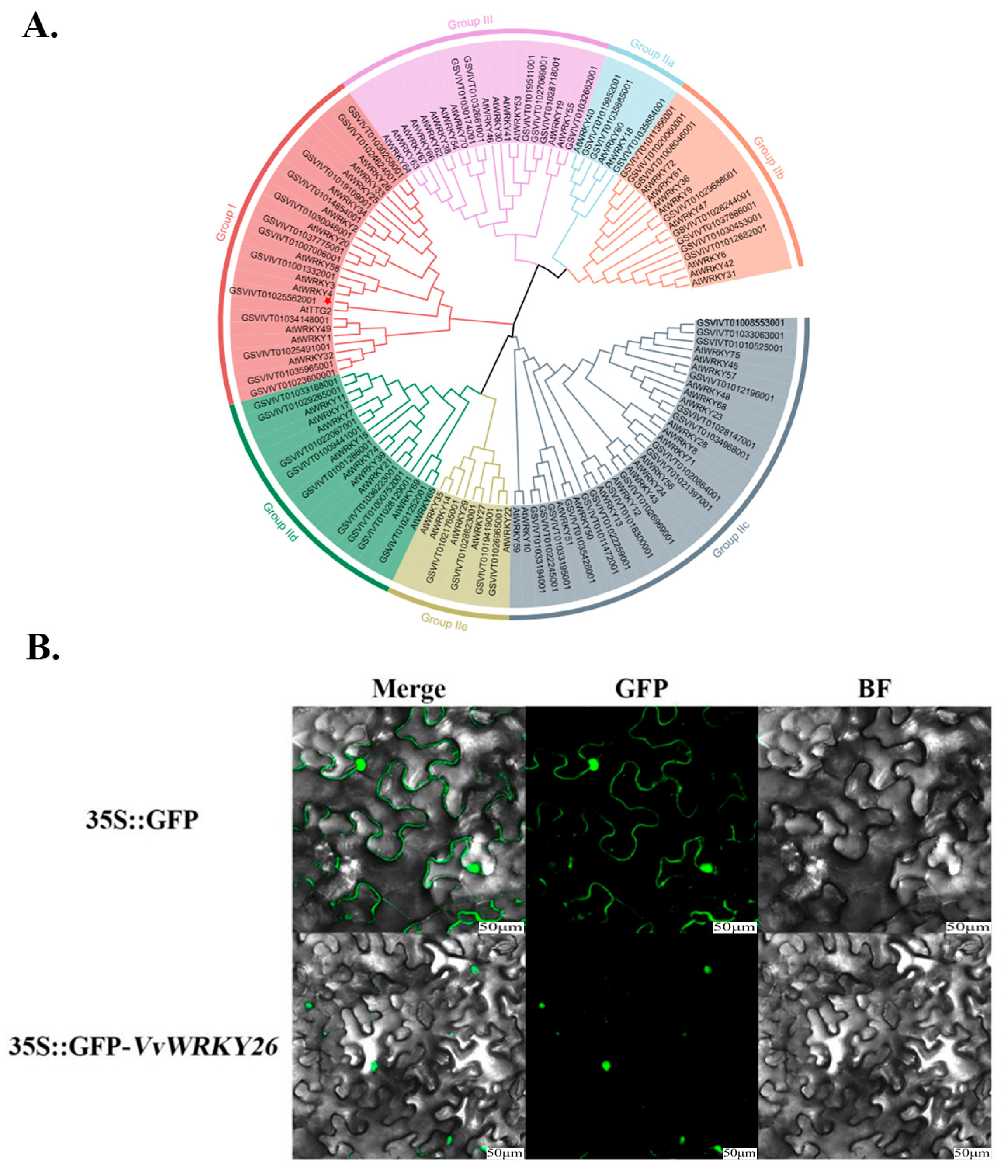
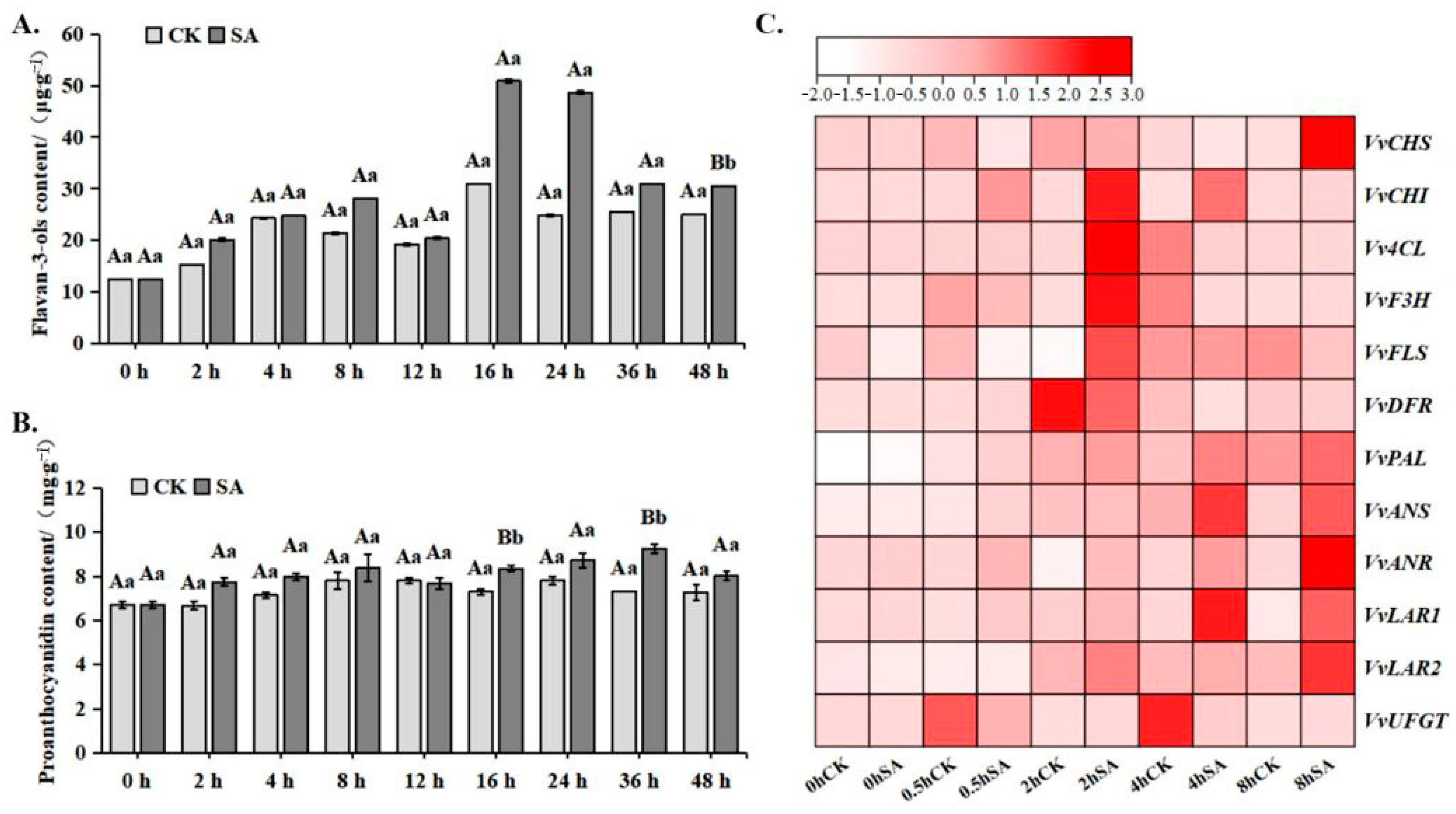
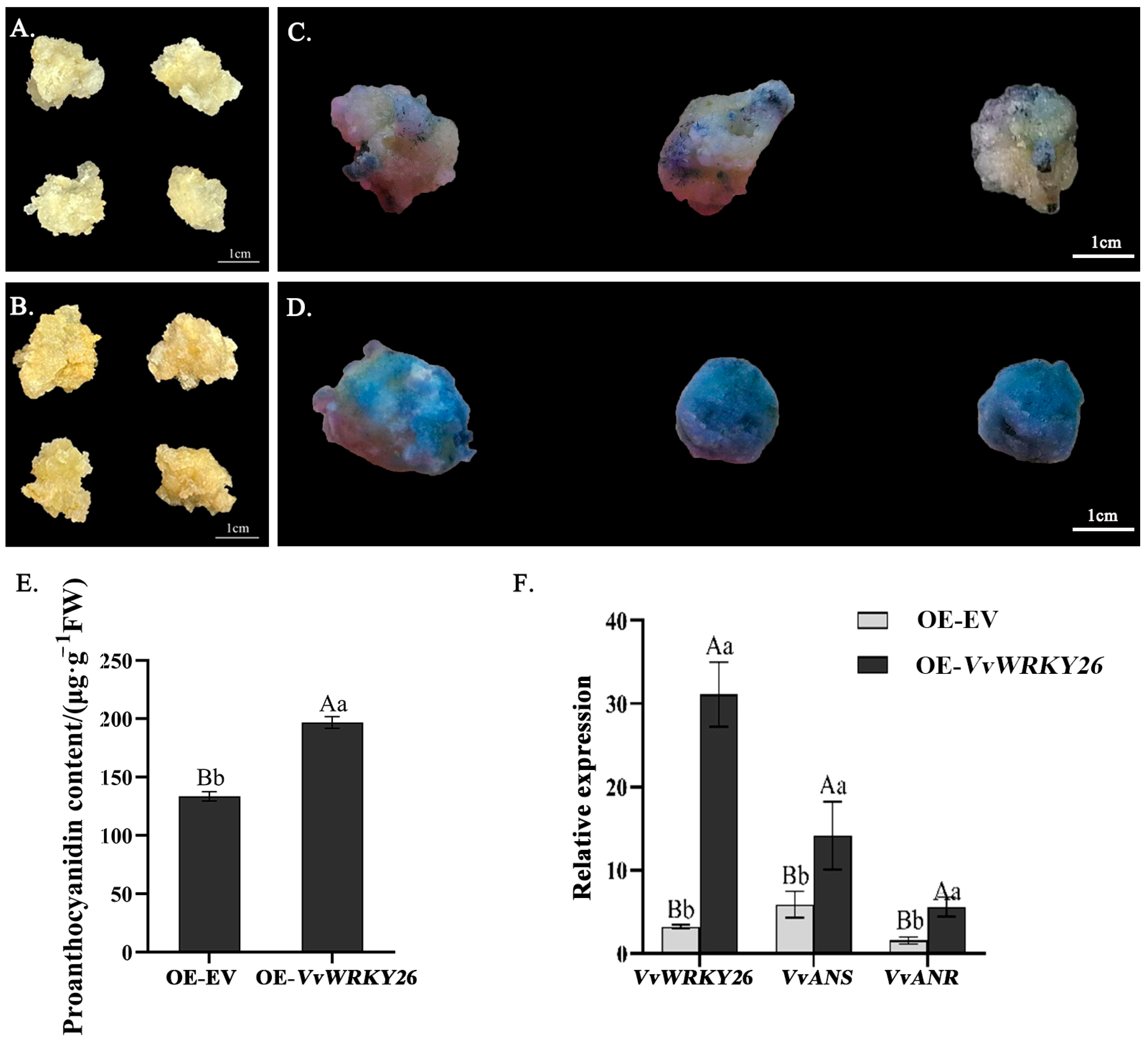
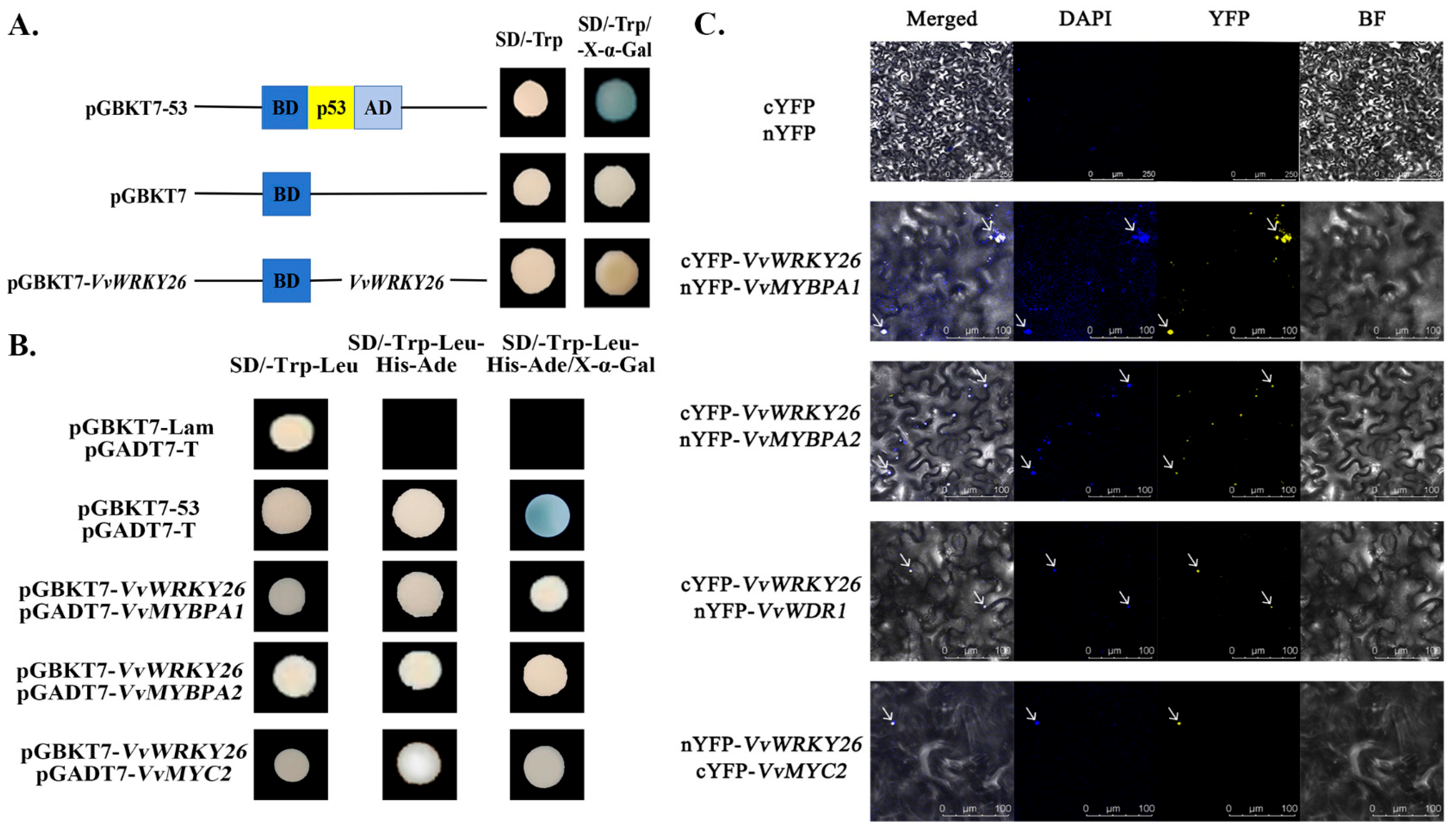
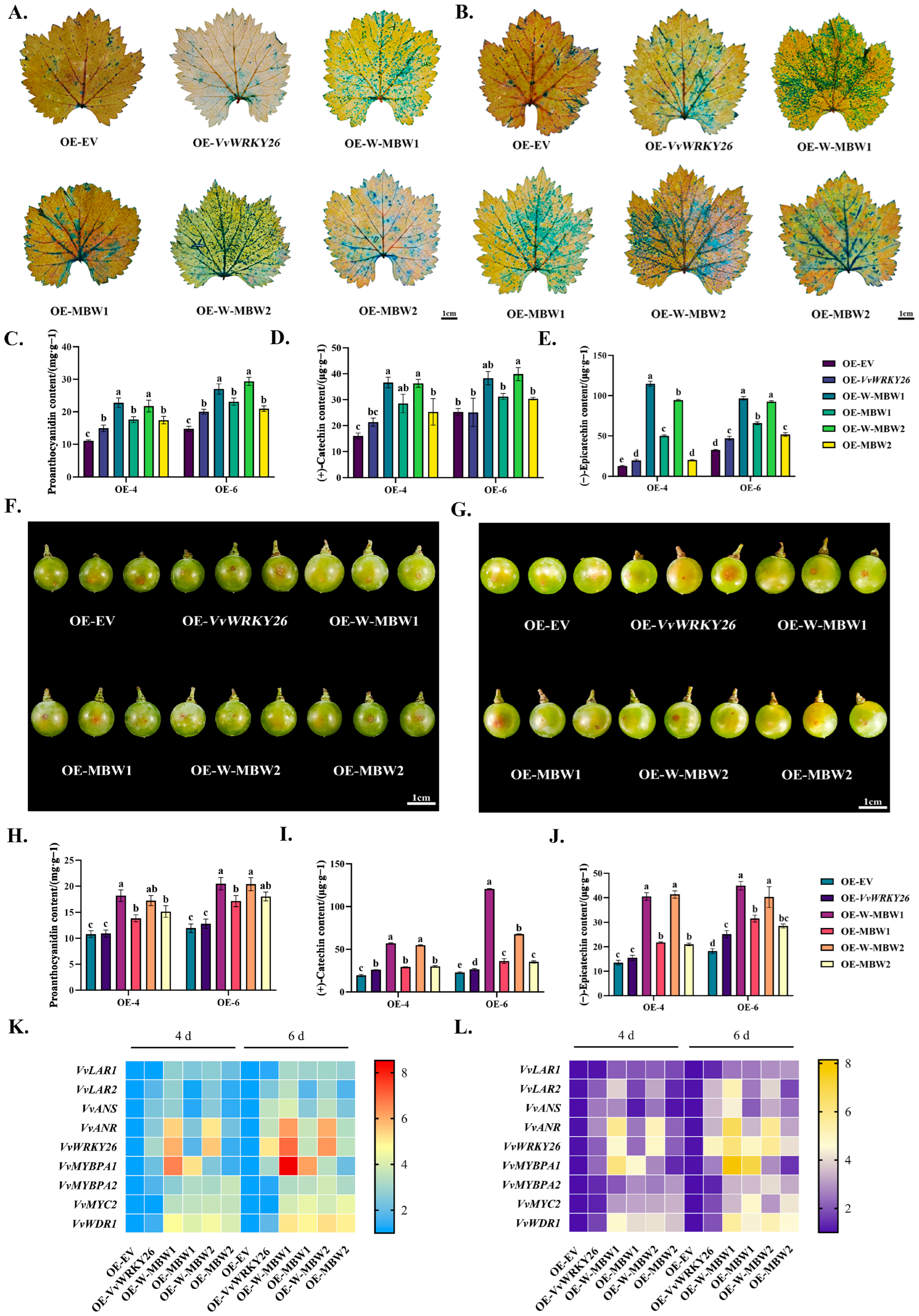
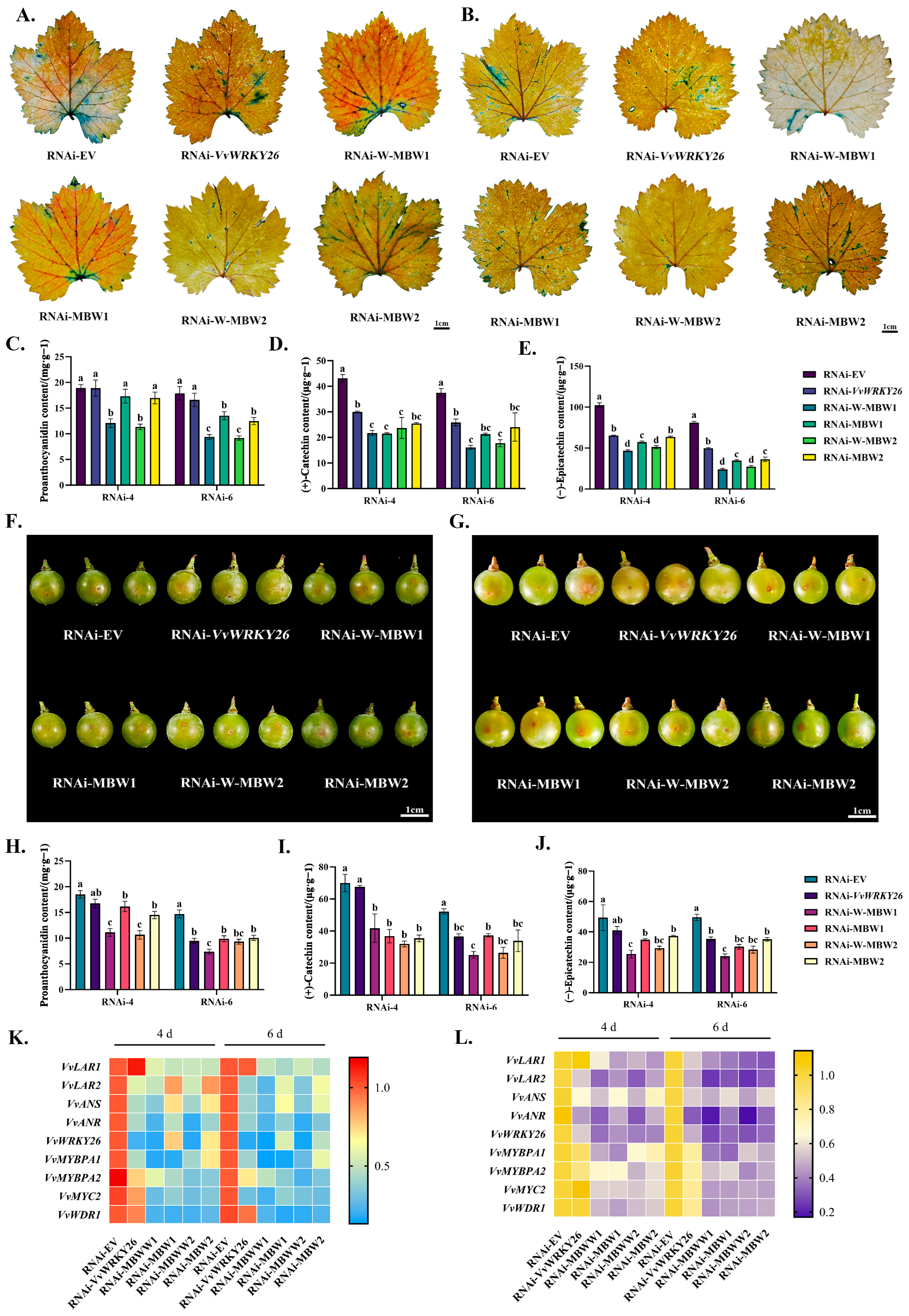
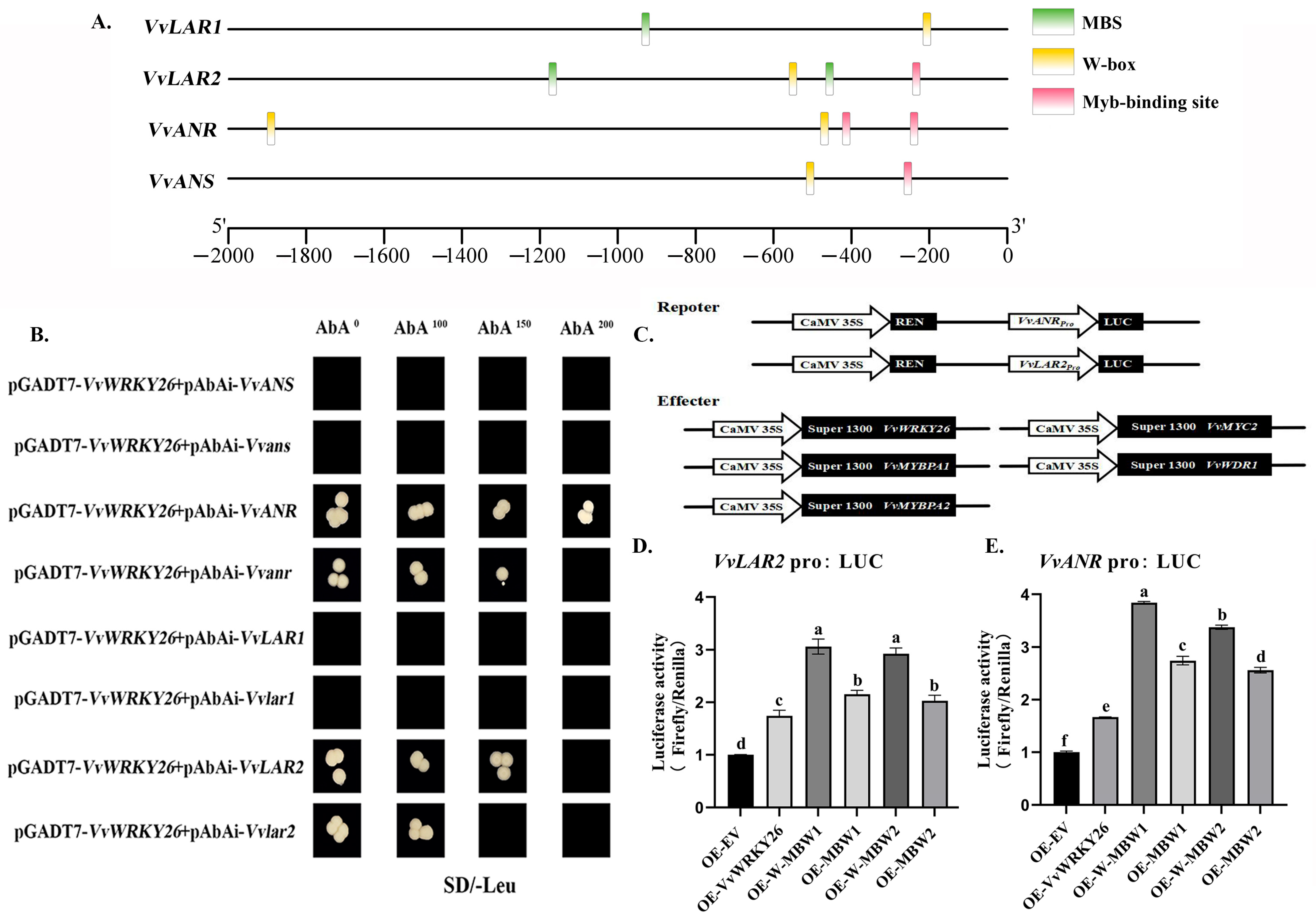
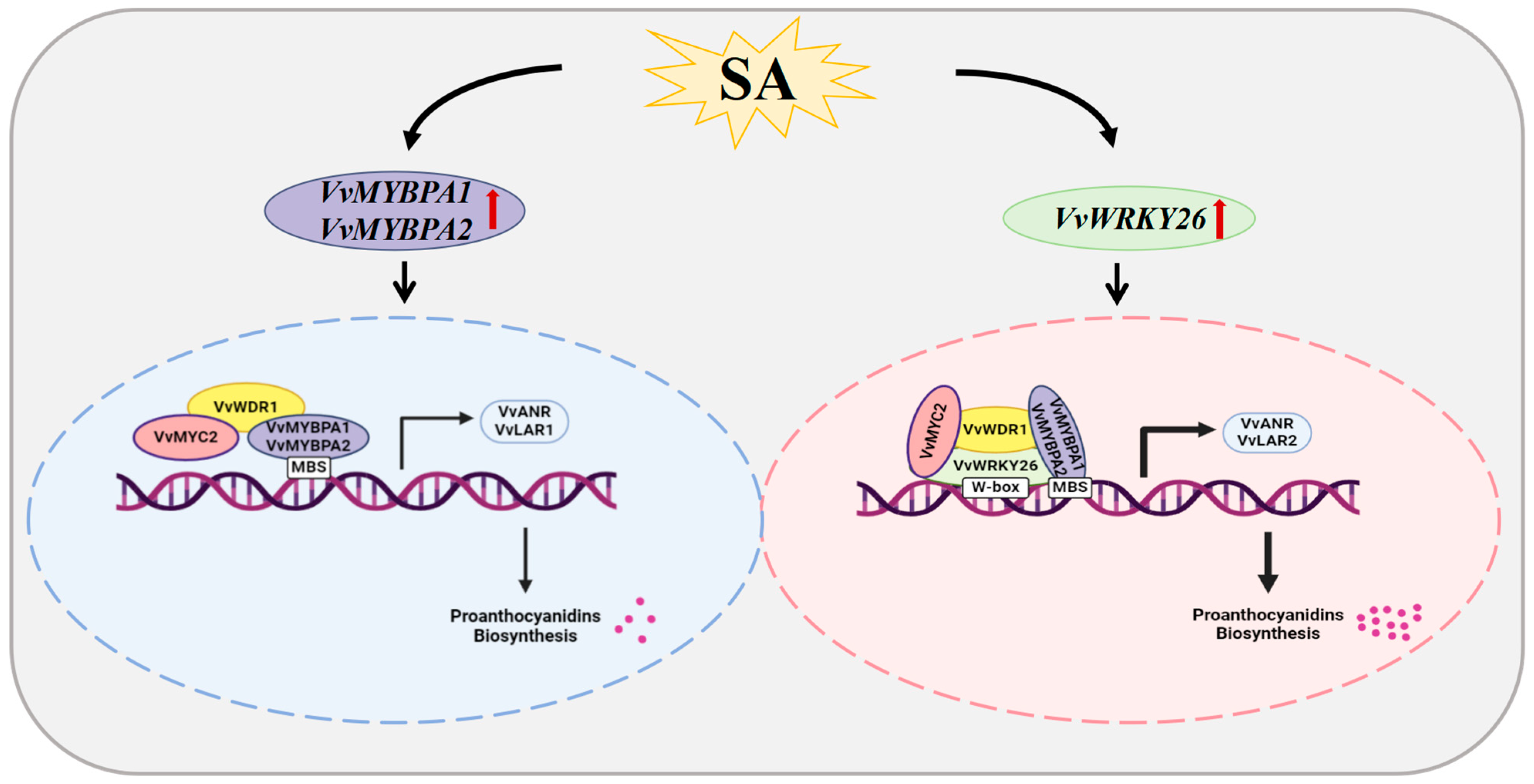
Disclaimer/Publisher’s Note: The statements, opinions and data contained in all publications are solely those of the individual author(s) and contributor(s) and not of MDPI and/or the editor(s). MDPI and/or the editor(s) disclaim responsibility for any injury to people or property resulting from any ideas, methods, instructions or products referred to in the content. |
© 2025 by the authors. Licensee MDPI, Basel, Switzerland. This article is an open access article distributed under the terms and conditions of the Creative Commons Attribution (CC BY) license (https://creativecommons.org/licenses/by/4.0/).
Share and Cite
Zhang, P.; Feng, Y.; Du, X.; Hao, Z.; Liang, J.; Wen, P. The VvWRKY26-MBW Complex Induced by Salicylic Acid Promotes the Accumulation of Proanthocyanidins in Grape. Plants 2025, 14, 3272. https://doi.org/10.3390/plants14213272
Zhang P, Feng Y, Du X, Hao Z, Liang J, Wen P. The VvWRKY26-MBW Complex Induced by Salicylic Acid Promotes the Accumulation of Proanthocyanidins in Grape. Plants. 2025; 14(21):3272. https://doi.org/10.3390/plants14213272
Chicago/Turabian StyleZhang, Pengfei, Yuyu Feng, Xiaoran Du, Zhilong Hao, Jinjun Liang, and Pengfei Wen. 2025. "The VvWRKY26-MBW Complex Induced by Salicylic Acid Promotes the Accumulation of Proanthocyanidins in Grape" Plants 14, no. 21: 3272. https://doi.org/10.3390/plants14213272
APA StyleZhang, P., Feng, Y., Du, X., Hao, Z., Liang, J., & Wen, P. (2025). The VvWRKY26-MBW Complex Induced by Salicylic Acid Promotes the Accumulation of Proanthocyanidins in Grape. Plants, 14(21), 3272. https://doi.org/10.3390/plants14213272






